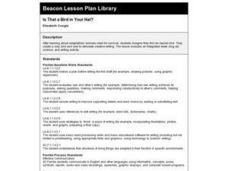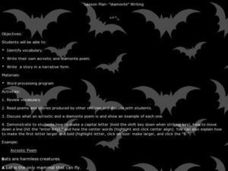New York State Department of Environmental Conservation
Adaptations – Designs for Survival
What's the difference between behavioral adaptations and physical adaptations? Learn about the various ways that organisms adapt to their environment with a worksheet about the creatures of the Hudson River.
Scholastic
Awesome Adaptations
Engaged learners discover how an owl beak works and how animals adapt to their environment. This task is part one of a three-part series.
Curated OER
Is That a Bird in Your Hat?
Second graders imagine they find an injured bird. They create a clay bird and nest to stimulate creative writing. The lesson includes an integrated week-long art, science, and writing activity.
Curated OER
Change or Adaptation
Students identify the adaptive forces in the life cycle of plants, animals, and humans, isolate and identify the role that change and adaptation play in extreme environments and research and write a short term paper using MLA citations.
Curated OER
Hawaiian Bird Beak Adaptation
Learners explore adaptation by participating in a lab activity. In this bird characteristics lesson, students discuss the different purposes birds have for their beaks and conduct an experiment testing which beaks collect food best....
Curated OER
The Legendary Raptors
How are raptors and airplanes alike? Combine science and language arts in this fun and interactive project. Young scientists research the animal in order to design their own aircraft, and compete in a contest for farthest, fastest, and...
Curated OER
Meet One Picky Bird
Students complete a research project In this endangered species lesson, students use the "Think, Puzzle, Explore" method to learn about endangered species. Students research and write a report on the red-cockaded woodpecker.
Curated OER
"For the Birds" [part I]
Students identify birds that appear in Chinese and Japanese art, learning about
their physical characteristics, classifying them according to scientific principles, and exploring their habitats and migration patterns. This is part one...
Curated OER
Birds & Caterpillars
In this biology learning exercise, learners explain the use of camouflage as a defense mechanism. Then they list examples of insects that use camouflage to protect them from predators. Students also identify and name other types of...
University of Kentucky
The Great Spider Debate
Poor, misunderstood spiders! They are feared, disrespected, and detested by many people, yet they do so many positive things. A great addition to any insect unit, learn about some of the more common spiders, while hopefully dispelling...
Curated OER
Specialized Structures and Environments
Fifth graders explore biology by completing an Internet activity in class. For this adaptation lesson, 5th graders identify several organisms and mammals that fight for their existence through slow changes to their anatomy over the...
Curated OER
Feathers for Lunch Lesson Plan
Students discover different types of birds and the habitats in which the dwell. In this bird lesson, students read Feathers for Lunch, discuss bird facts, and build a bird habitat.
Curated OER
Biodiversity Bird Hunt
Students examine the influence of biodiversity on human culture through the use of birds. They brainstorm words that come to mind when they think of human cultures. They describe ways that human culture and biodiversity are linked.
Curated OER
The Great Horned Owl
In this recognizing facts about the Great Horned Owl worksheet, students read fun facts, match illustrations with adaptations, sequence life cycle cards, and read what to do if they find an injured bird. Students solve 16 answers.
Curated OER
What is a Raptor?
Students explore, analyze and discover the characteristics of raptors and generate a word bank for owls and raptors. They identify attributes shared by raptors and practice various key vocabulary words to master and utilize in sentence...
Curated OER
Choose Your Defense: Spines, Vomit and Camouflage
Students investigate defensive mechanisms of insects and organisms. For this biology lesson, students draw imaginary caterpillars as well as imaginary parasites that will harm the caterpillar. Students utilize the Internet to discover...
Curated OER
Diamonte Writing
Students discover poetry while practicing their storytelling skills. In this language arts lesson, students read diamonte and acrostic poems written by other students on the Internet. Students create their own narrative stories about a...
Curated OER
Wetland Metaphors
Students describe the characteristics of wetlands and identify their ecological functions. They inspect items and use them to create metaphors about wetlands.
Curated OER
Designasaurus: Modeling Activity for a Paleoartist
Students create and draw fictional dinosaurs. They write a description of their dinosaur.
Curated OER
Animals Antonyms and Synonyms Worksheet
Create a cross-curricular connection for your upper elementary language arts kids. There are 15 vocabulary words listed in the chart, and each has to do with exploring different ecosystems. For each word, the learner must find an antonym...
Field Museum
The Case of Darwin's Finches
One of the most striking pieces of evidence for Darwin's Evolution of Species was his observations of finches and how their beaks differed from island to island, depending on their primary food sources. So what would happen to the theory...
Curated OER
A Year (a Day or a Week) In My Life as a Shorebird
Students describe the basic life history of one shorebird common to their area. They use the writing process which includes brainstorming, rough draft writing, peer editing, and re-writing to create a factually and grammatically...
Curated OER
Animal Facts
Fourth graders list five facts about an assigned animal, and complete a bird beak activity, using pliers, blunt pencils, forceps, clothespins, and a spoon that represent different types of beaks; students complete chart showing best type...
Curated OER
Comparing Human and Avian Skeletons
In this human and avian skeleton review activity, students read about both skeletal systems and respond to 10 fill in the blank and drawing questions.









!["For the Birds" [part I] Lesson Plan "For the Birds" [part I] Lesson Plan](http://content.lessonplanet.com/resources/thumbnails/122462/large/cgrmlwnvbnzlcnqymdeymtaxny0ynji5lwd4n2h5by5qcgc.jpg?1414222903)















